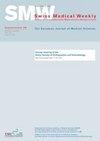晚期早产儿和足月儿阴道分娩和剖腹产后新生儿呼吸系统发病率--一项回顾性队列研究
IF 2.1
4区 医学
Q2 MEDICINE, GENERAL & INTERNAL
引用次数: 0
摘要
背景:呼吸窘迫综合征是晚期早产儿(胎龄 34-36 周)和足月儿(胎龄 37-41 周)入住新生儿重症监护室的主要原因。选择剖腹产后,呼吸系统发病的风险似乎会增加,而使用产前皮质类固醇则可能会降低这种风险。然而,在考虑对 34 周后早产高风险产妇使用产前皮质类固醇之前,需要进一步评估呼吸窘迫综合征的发病率以及分娩方式对这一发病率的影响。因此,本研究旨在调查晚期早产儿和足月儿呼吸窘迫综合征的发生率与分娩方式之间的关系。方法:在这项回顾性队列研究中,我们查询了苏黎世大学医院和巴塞尔大学医院的临床数据库中所有 34+0 到 41+6 周之间的活产婴儿。结果:在排除畸形(889 例)和不完整或不确定数据(383 例)后,对 38382 例婴儿中的 37110 例进行了评估。其中,5.34%(n = 1980)的婴儿因呼吸窘迫综合征入住新生儿重症监护室。无论胎龄大小,经阴道自然分娩的婴儿呼吸窘迫综合征发生率为 2.92%;经阴道手术分娩的婴儿呼吸窘迫综合征发生率为 4.02%;选择剖腹产的婴儿呼吸窘迫综合征发生率为 8.98%;二次剖腹产的婴儿呼吸窘迫综合征发生率为 8.45%;紧急剖腹产的婴儿呼吸窘迫综合征发生率为 13.3%。与自然阴道分娩相比,选择剖腹产后发生呼吸窘迫综合征的风险更高,根据胎龄调整后的几率比(OR)为 2.31(95% CI 1.34周时的几率比(OR)为2.31(95% CI 1.49-3.56),35周时的几率比(OR)为5.61(95% CI 3.39-9.3),36周时的几率比(OR)为1.5(95% CI 0.95-2.38),37周时的几率比(OR)为3.28(95% CI 1.95-5.54),38周时的几率比(OR)为2.51(95% CI 1.65-3.81)。在 39 周时,选择剖腹产与自然阴道分娩后发生呼吸窘迫综合征的风险没有明显差异。结论:与自然阴道分娩的婴儿相比,胎龄小于 39 周的婴儿在选择剖腹产后呼吸窘迫综合征的发生率要高出三倍。因此,在可能的情况下,应计划在孕满 38 周后进行选择性剖腹产,以最大限度地降低新生儿呼吸系统发病的风险。本文章由计算机程序翻译,如有差异,请以英文原文为准。
Incidence of neonatal respiratory morbidity after vaginal and caesarean delivery in the late-preterm and term period – a retrospective cohort study
BACKGROUND: Respiratory distress syndrome is a leading cause of neonatal intensive care unit admissions for late preterm (34–36 weeks gestational age) and term infants (37–41 weeks). The risk for respiratory morbidity appears to increase after an elective caesarean delivery and might be reduced after antenatal corticosteroids. However, before considering antenatal corticosteroids for women at high risk of preterm birth after 34 weeks, the incidence of respiratory distress syndrome and the effect of delivery mode on this incidence requires further evaluation. Therefore, this study aimed to investigate the relationship between respiratory distress syndrome incidence and delivery mode in late preterm and term infants.
METHODS: In this retrospective cohort study, the clinical databases of the University Hospitals of Zurich and Basel were queried regarding all live births between 34 + 0 and 41 + 6 weeks. Neonatal intensive care unit admissions due to respiratory distress syndrome were determined and analysed in regard to the following delivery modes: spontaneous vaginal, operative vaginal, elective caesarean, secondary caesarean and emergency caesarean.
RESULTS: After excluding malformations (n = 889) and incomplete or inconclusive data (n = 383), 37,110 infants out of 38,382 were evaluated. Of these, 5.34% (n = 1980) were admitted to a neonatal intensive care unit for respiratory distress syndrome. Regardless of gestational age, respiratory distress syndrome in infants after spontaneous vaginal delivery was 2.92%; for operative vaginal delivery, it was 4.02%; after elective caesarean delivery it was 8.98%; following secondary caesarean delivery, it was 8.45%, and after an emergency caesarean it was 13.3%. The risk of respiratory distress syndrome was higher after an elective caesarean compared to spontaneous vaginal delivery, with an odds ratio (OR), adjusted for gestational age, of 2.31 (95% CI 1.49–3.56) at 34 weeks, OR 5.61 (95% CI 3.39–9.3) at 35 weeks, OR 1.5 (95% CI 0.95–2.38) at 36 weeks, OR 3.28 (95% CI 1.95–5.54) at 37 weeks and OR 2.51 (95% CI 1.65–3.81) at 38 weeks. At 39 weeks, there was no significant difference between the risk of respiratory distress syndrome after an elective caesarean vs. spontaneous vaginal delivery. Over the study period, gestational age at elective caesarean delivery remained stable at 39.3 ± 1.65 weeks.
CONCLUSION: The incidence of respiratory distress syndrome following an elective caesarean is up to threefold higher in infants born with less than 39 weeks gestational age compared to those born by spontaneous vaginal delivery. Therefore — and whenever possible — an elective caesarean delivery should be planned after 38 completed weeks to minimise the risk of respiratory morbidity in neonates.
求助全文
通过发布文献求助,成功后即可免费获取论文全文。
去求助
来源期刊

Swiss medical weekly
医学-医学:内科
CiteScore
5.00
自引率
0.00%
发文量
0
审稿时长
3-8 weeks
期刊介绍:
The Swiss Medical Weekly accepts for consideration original and review articles from all fields of medicine. The quality of SMW publications is guaranteed by a consistent policy of rigorous single-blind peer review. All editorial decisions are made by research-active academics.
 求助内容:
求助内容: 应助结果提醒方式:
应助结果提醒方式:


